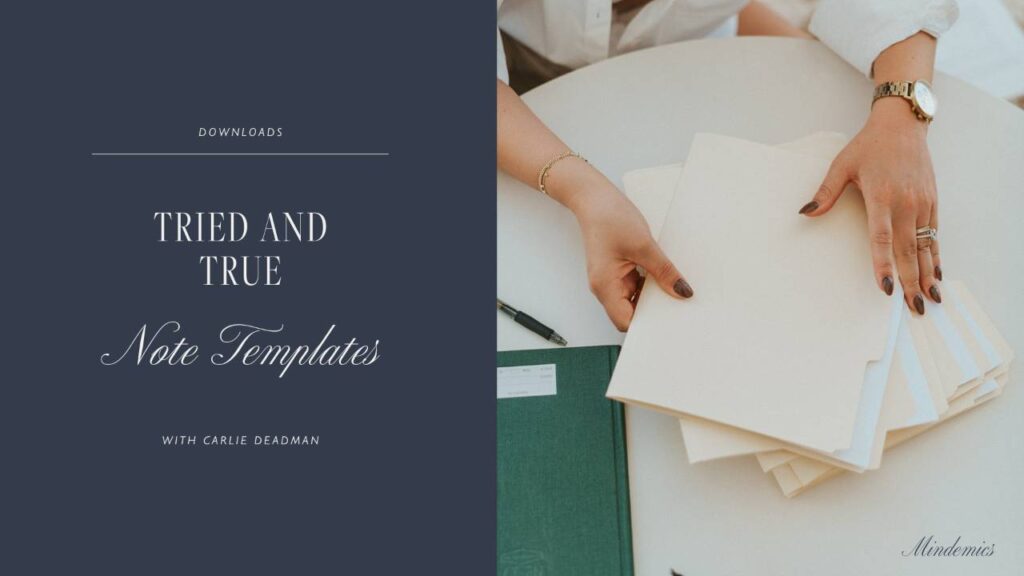

Let’s be honest: as therapists, we’ve all been there…sitting at your desk after a long day of sessions, staring at a blank screen, and feeling that dread of having to write clinical notes. It can feel like the last thing you want to do when all you really want is to decompress after a day of sessions. Good documentation is not just a requirement of our job, it really can make the difference in effectiveness of care. It helps you keep track of your clients’ progress, stay organized, and meet all those legal and ethical requirements.
What if I told you there’s a way to make this process faster, easier, and way less stressful? Enter clinical note templates. Let’s take some time and chat about how using these templates can save you time, help you stay consistent, and make your therapy documentation stress-free so you can focus on what really matters: your clients.
In this post I’ll walk you through the different types of clinical note templates—like SOAP, DAP, Intake, and Treatment Plan templates—and how they can improve your therapy documentation. I’ll also share how using these templates has helped me stay organized in my practice and why I highly recommend incorporating them into your practice.
Why Clinical Note Templates Matter
As therapists, we all know how important it is to keep accurate, detailed records. I like to think about clinical notes as a therapeutic tool in itself. Properly written notes can help track progress, highlight patterns, and guide future treatment decisions.
Without a solid framework writing therapy notes can be an overwhelming task. Some of the main reasons I believe clinical note templates are worthwhile…
- Efficiency: Instead of starting from scratch each time, you have a pre-built structure to fill in, which helps speed up the documentation process.
- Consistency: Templates help maintain a consistent format across all your notes, ensuring you cover all necessary points every time.
- Accuracy: With a template, you’re less likely to forget important details or leave gaps in your documentation.
- Clarity: A well-structured note is easier to read and understand, both for you and for anyone else who may need to review the record later.
I can’t tell you how much stress clinical note templates have helped me avoid over the years. These are some of the widely used clinical note templates:
SOAP Notes
One of the most commonly used clinical note formats is the SOAP method. SOAP stands for Subjective, Objective, Assessment, and Plan; it’s a simple structure for documenting therapy sessions. Let’s break it down…
- S: Subjective – This is where you record what the client has shared about their current feelings, experiences, and concerns. It’s based on their own perspective and should capture their mood, symptoms, or any significant events they’ve experienced since the last session.
- O: Objective – This part is for documenting any observable facts, such as the client’s behavior, appearance, or affect. It could also include results from assessments or clinical observations you made during the session.
- A: Assessment – In this section you evaluate the client’s progress and note changes or patterns that are showing. Also a great spot to note how the client is responding to the treatment or interventions you’ve been using.
- P: Plan – The Plan section is where you outline the next steps for treatment including any goals, interventions, or follow-up tasks. You could also note any homework assignments for the client or suggest new strategies to try.
Using a SOAP template can help you cover all the necessary aspects of each session in a clear, organized way. It’s a way of documenting what happened in session and also making meaningful observations that can guide future sessions.
DAP Notes
Another popular clinical note template (and my personal fav) is the DAP method. DAP stands for Data, Assessment, and Plan. Pretty similar to SOAP notes but DAP notes can be a bit more flexible and for therapists who might prefer a more streamlined format.
- D: Data – This is where you record both subjective and objective information. You can combine the client’s self-report with any observations you’ve made during the session.
- A: Assessment – Like SOAP, the Assessment section is for analyzing the client’s progress, identifying patterns, and assessing how well the treatment is working.
- P: Plan – This section outlines the plan for the next steps in therapy, similar to the “Plan” section of a SOAP note.
I’ve found that DAP notes work well especially when considering clients who are making progress and where the session is more focused on tracking that progress.
Intake Notes
Okay let’s talk about the intake note. The intake session is SO important for setting the tone for the treatment process and therapeutic relationship. An Intake Note Template should include sections for…
- Client Background: This includes demographic information, reason for seeking therapy, and any relevant history (i.e. mental health or treatment history, medical history, family history).
- Presenting Concerns: Document what the client shares about their current struggles, including symptoms, behaviors, and emotions they are experiencing. I like to include a few direct quotes from the client here as well!
- Goals and Expectations: Make sure to clarify the client’s goals for therapy and what they hope to achieve through treatment.
Your future self will thank you for taking the time to note all the important info that is gathered in that intake session- trust me!
Treatment Plan Templates
Once you’ve completed the intake session and have a better understanding of your client’s needs/goals, you’ll typically move into creating a Treatment Plan. This document outlines the goals, interventions, and strategies you’ll use to guide your client’s progress.
A Treatment Plan Template typically includes:
- Diagnosis: Listing the specified diagnosis/diagnoses for transparency and meeting your board’s requirements.
- Client’s Goals: These should be specific, measurable, and tailored to the client’s needs.
- Interventions: This is where you list the specific interventions and therapeutic methods you’ll be using (i.e. CBT, EMDR, DBT).
- Expected Outcomes: This section helps set realistic expectations for progress and outlines how you’ll measure success.
- Timeline: Set a timeframe for reaching certain milestones or goals.
- Review Date: The date listed that is clinically appropriate/required for compliance to review the plan again.
A Treatment Plan Template helps you stay focused on your client’s goals and ensures that you’re actively working toward measurable progress. Some of the best moments in the therapy room are sitting with a client and getting to recognize progress on treatment goals or completion of goals!
Why You Should Use Clinical Note Templates in Your Practice
I am such a why person. I need to know why it’s worth considering before I spend the energy! So let’s talk about why clinical note templates should be a part of your practice.
Save Time
With a clear structure already in place you can quickly jot down important details without getting bogged down in figuring out what to include in a note.
Minimize Errors
Templates reduce the chances of forgetting important information that way your notes remain complete and accurate.
Improve Communication
Well-organized notes are easier for others (like supervisors or consultants) to read and understand so it helps make coordination of care or seeking guidance a whole lot easier.
Boost Client Care
By keeping track of progress and adjusting the treatment plan as needed, you can provide more personalized care through recognizing patterns and changes in behavior.
As a therapist you don’t want to be spending your time thinking about notes, you want to be able to focus on your clients! After years of consistency with note templates I’ve found it makes the job less stressful and so much easier when leading a practice.
Ready to Try Clinical Note Templates?
If you’re ready to make clinical notetaking feel a little less daunting, check out our Tried and True Note Templates* pack. These templates are crafted with your needs in mind, helping you stay organized, save time, and ensure your documentation is compliant. I’m excited for you to experience how much smoother the documentation process can be!

